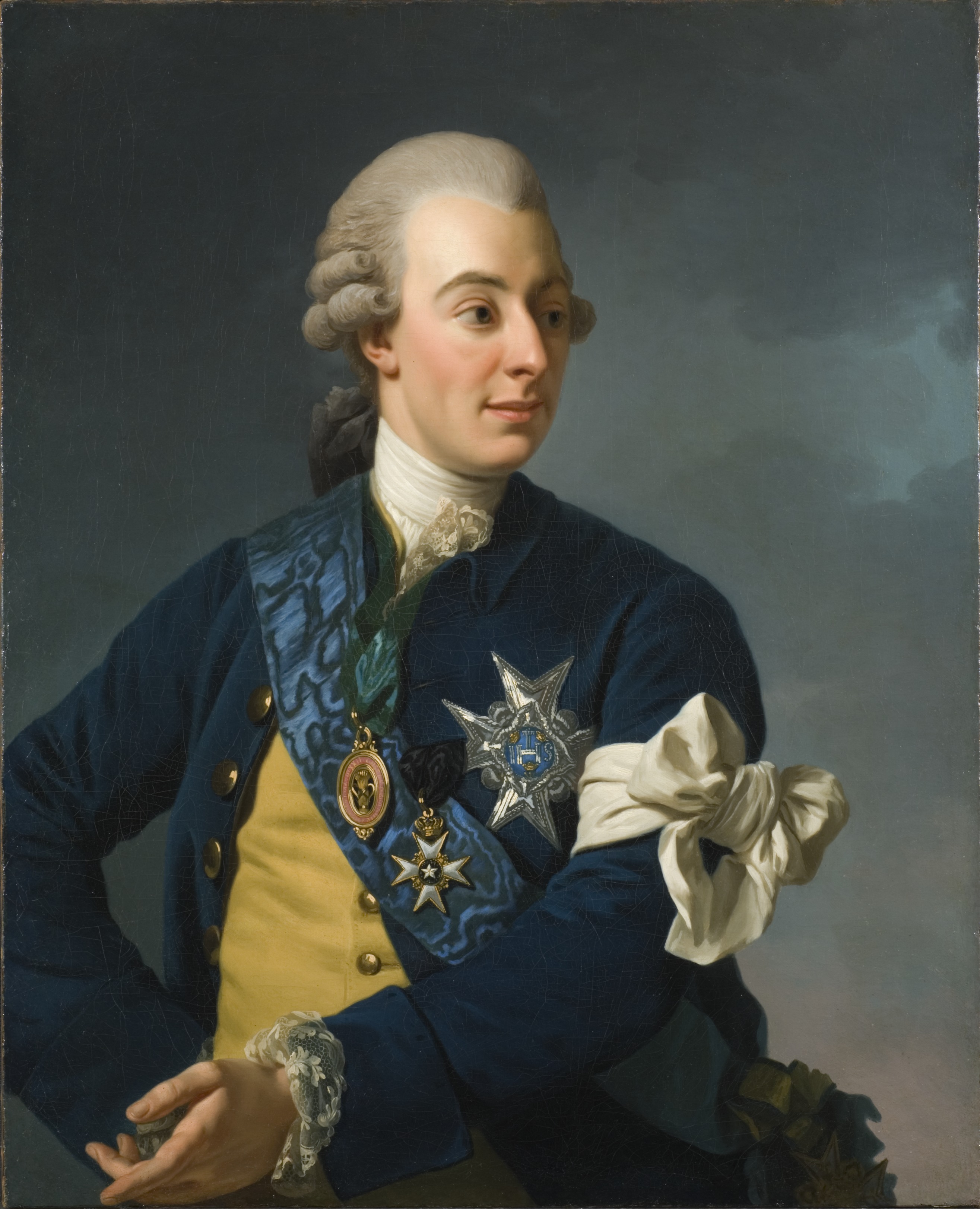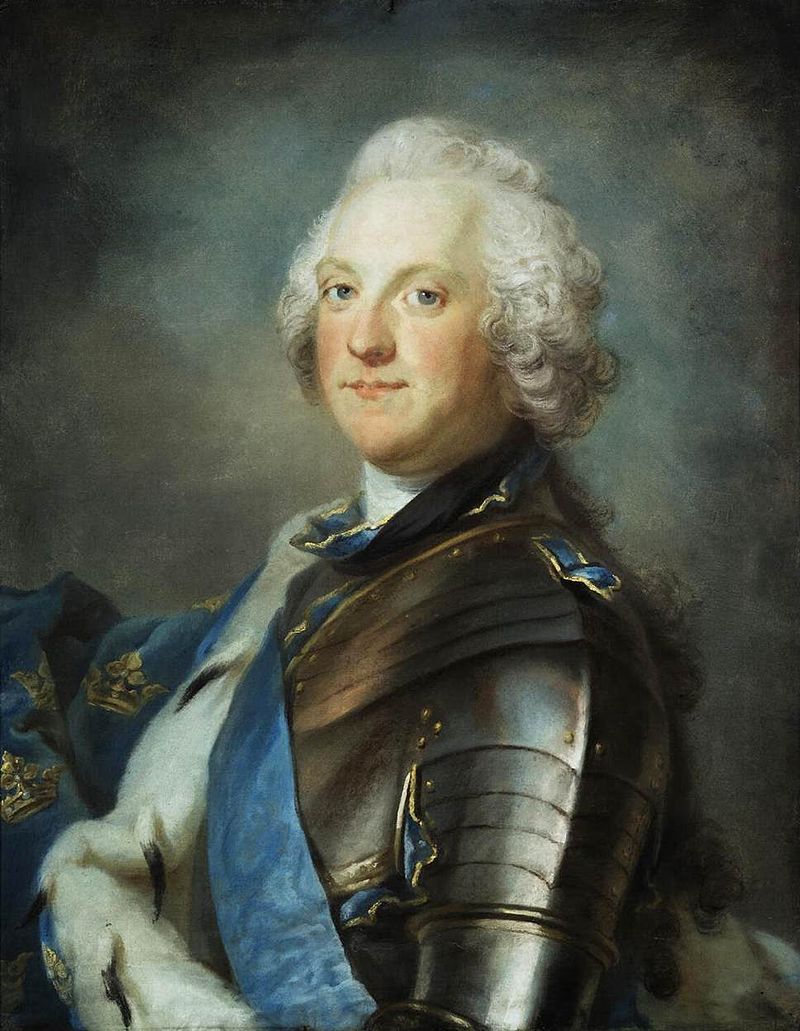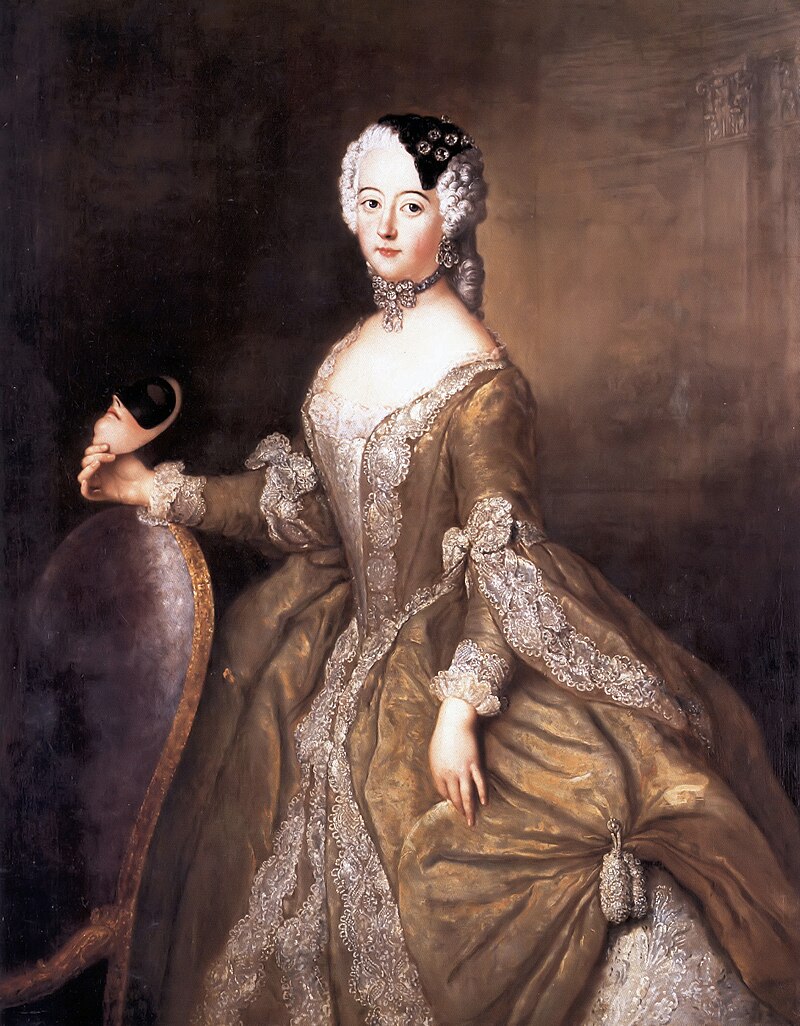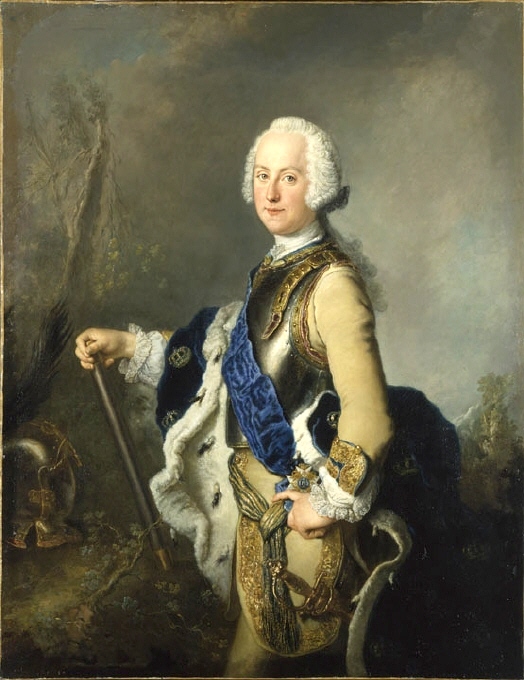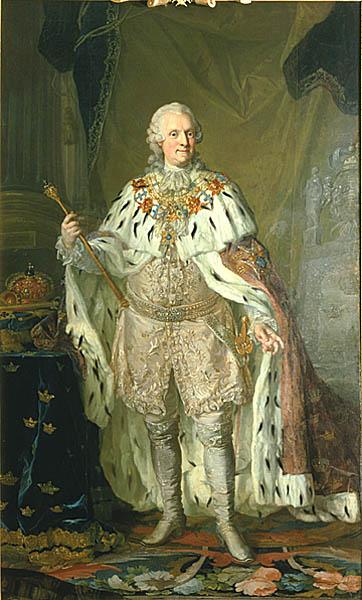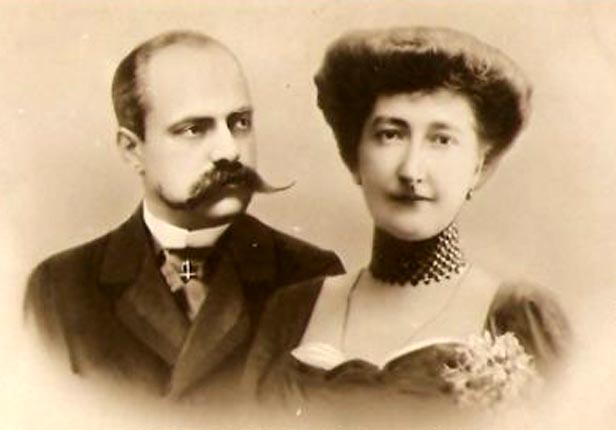by Susan Flantzer
© Unofficial Royalty 2017

Credit – Wikipedia
King Gustav IV Adolf became king at the age of 13 when his father was assassinated and his reign lasted until he was deposed 17 years later in a coup. He was born at the Royal Palace of Stockholm on November 1, 1778, the elder of the two sons of King Gustav III of Sweden and Princess Sophia Magdalena of Denmark, daughter of King Frederik V of Denmark and his first wife Princess Louise of Great Britain, daughter of King George II of Great Britain.
The marriage of Gustav Adolf’s parents remained unconsummated for ten years. There were various theories regarding the cause including his mother’s strict religious upbringing and introverted character, his father’s sexuality, and the possibility that either or both Queen Sophia Magdalena and King Gustav III had some kind of physical problem. Eventually, Count Adolf Fredrik Munck af Fulkila acted as a sexual instructor for the couple. The instruction resulted in the birth of Gustav Adolf. When it became known that Munck participated in the reconciliation between the royal couple, there were rumors that he was Gustav Adolf’s father.
Gustav Adolf had one younger brother who died in infancy:
- Prince Carl Gustav, Duke of Småland (1782–1783)

Gustav Adolf in 1785; Credit – Wikipedia
At the time of his birth, Gustav Adolf was put under the care of Maria Aurora Uggla, a lady-in-waiting and confidant of Queen Sophia Magdalena. As Crown Prince, Gustav Adolf began his education before he was three years old with Count Fredrik Sparre. When he was ten-years-old, Gustav Adolf received the Royal Order of the Seraphim.
On March 16, 1792, King Gustav III was shot by Jacob Johan Anckarström during a masked ball at the Royal Opera House in Stockholm. Thirteen days later, on March 29, 1792, King Gustav III died of his wounds at the Royal Palace of Stockholm at the age of 46. His 13-year-old son succeeded him as King Gustav IV Adolf. Prince Carl, Duke of Södermanland, the young king’s paternal uncle, served as regent until 1796. Carl was not willing or not capable of managing state affairs and he entrusted the power of government to his confidant Count Gustaf Adolf Reuterholm. Nils von Rosenstein, the first permanent secretary of the Swedish Academy, served as Gustav Adolf’s tutor.

King Gustav IV Adolf in 1793; Credit – Wikipedia
In 1795, Gustav Adolph was betrothed to Duchess Louise Charlotte of Mecklenburg-Schwerin. The engagement was arranged by Count Gustaf Adolf Reuterholm, the confidant of the regent Prince Karl, who wished to keep his influence after Gustav Adolf was declared of legal majority by having a queen indebted to him for her position. Gustav Adolf was initially positive about marrying Louise Charlotte and the engagement was celebrated in the courts of Sweden and Mecklenburg-Schwerin. However, Empress Catherine the Great of Russia wanted her granddaughter Grand Duchess Alexandra Pavlovna of Russia to be Queen of Sweden and made her dislike of the engagement known. Because of this, many people told Gustav Adolf that Louise Charlotte, whom he had not seen, was not beautiful. When Gustav Adolf was declared of legal majority in 1796, he broke off the engagement to Louise Charlotte. Her father demanded compensation. In 1803, the matter was finally settled when the Swedish city of Wismar in Germany was turned over to Mecklenburg-Schwerin.
Around the time of his betrothal to Louise Charlotte, Gustav Adolf had fallen in love with Ebba Modée, a maid of honor to Hedwig Elizabeth Charlotte of Holstein-Gottorp, the wife of Gustav Adolf’s uncle Prince Karl. He offered to call off his engagement to Louise Charlotte, abdicate, and elope with her to Bohemia. She declined and encouraged him to go on his trip to Russia in 1796, where he was to be engaged to the Grand Duchess Alexandra Pavlovna. However, the Russian engagement fell through because Gustav Adolph refused to allow his prospective bride to continue to practice her Russian Orthodox religion.

Gustav Adolf and Frederica, circa 1797-1800; Credit – Wikipedia
After all the problems with prospective brides, Gustav Adolf arranged his own marriage. During his 1796 visit to Russia, he met the former Louise of Baden who was married to the future Alexander I, Emperor of Russia. Louise had a sister Frederica and since Gustav Adolf thought Louise was beautiful, he expected the same of her sister. He visited Frederica and her parents, Karl Ludwig, Hereditary Prince of Baden and Amalie of Hesse-Darmstadt, in August 1797, and immediately Gustav Adolf and Frederica became engaged. On October 6, 1797, Frederica of Baden was married by proxy to King Gustav IV Adolf in Stralsund in Swedish Pomerania with Swedish Baron Evert Taube standing in for the king. Baron Taube accompanied Frederica to Sweden where a second wedding ceremony was held on October 31, 1797, in the Royal Chapel at the Royal Palace of Stockholm.
The couple had five children:
- Crown Prince Gustaf, after 1809 known as Gustaf Gustafsson von Holstein-Gottorp, Prince of Vasa (1799 – 1877), married Princess Louise Amelie of Baden, had one son who died in infancy and one daughter Princess Carola who married King Albert I of Saxony
- Princess Sofia (1801 – 1865), married Grand Duke Leopold I of Baden, had eight children including Alexandrine who married Ernst II, Duke of Saxe-Coburg and Gotha and Friedrich I, Grand Duke of Baden whose daughter Victoria of Baden married King Gustaf V of Sweden
- Prince Carl Gustaf (1802 – 1805), died in childhood
- Princess Amalia (1805 – 1853), unmarried
- Princess Cecilia (1807 – 1844), married Augustus, Grand Duke of Oldenburg, had three sons
In 1805, Gustav Adolf joined the Third Coalition against Napoleon. His campaign went poorly and the French occupied Swedish Pomerania. In 1807, Russia made peace with France. A year later, Russia invaded Finland, which was ruled by Sweden, attempting to force Gustav Adolf to join Napoleon’s Continental System. In just a few months, almost all of Finland was lost to Russia. In 1809, Sweden surrendered the eastern third of Sweden to Russia, and the autonomous Grand Principality of Finland within the Russian Empire was established.
Provoked by the disaster in Finland, a group of noblemen started a coup d’état that deposed King Gustav IV Adolf. On March 13, 1809, a group of conspirators led by Carl Johan Adlercreutz broke into the royal apartments at Gripsholm Castle and imprisoned Gustav Adolf and his family. Prince Karl, Gustav Adolf’s uncle, agreed to form a provisional government, and the Swedish parliament, the Riksdag, gave their approval for the coup. Gustav Adolf abdicated on March 29, 1809, thinking if he did so, his son would become king. However, on May 10, 1809, the Riksdag proclaimed that all members of Gustav Adolf’s family had forfeited their rights to the throne. After accepting a new liberal constitution, Prince Karl was proclaimed King Karl XIII of Sweden on June 6, 1809. In December 1809, Gustav Adolf and his family were sent into exile.
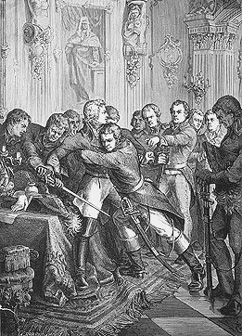
The arrest of Gustav Adolph; Credit – Wikipedia
Gustav Adolf and his family settled in Frederica’s home country, the Grand Duchy of Baden. However, the couple became incompatible and divorced in 1812. In the divorce settlement, Gustav Adolf renounced all his assets in favor of his mother and his children. He also renounced the custody and guardianship of his children. Two years later, Frederica placed her children under the guardianship of her brother-in-law, Alexander I, Emperor of Russia. Frederica settled in Bruchsal Castle in Baden. She acquired several other residences in Baden and a country villa, Villamont, near Lausanne, Switzerland, where she died in 1826.

Colonel Gustafsson, the former King Gustav IV Adolf, circa 1830; Credit – Wikipedia
Gustav Adolf ultimately settled in a small hotel in St. Gallen, Switzerland where he lived in great loneliness. He used several titles in exile: Count Gottorp, Duke of Holstein-Eutin, and Colonel Gustafsson. On February 7, 1837, Gustav Adolf suffered a stroke and died at the age of 58. He was originally buried at Eichhorn Castle in Moravia (now in the Czech Republic) where his son, the Austrian Lieutenant Field Marshal Gustav, Prince of Vasa lived. In 1881, his great-granddaughter Princess Victoria of Baden married Crown Prince Gustaf of Sweden, the future King Gustaf V. At the suggestion of the Crown Prince’s father King Oscar II of Sweden, Gustav Adolf’s body was returned to Sweden and interred in the Riddarholm Church, the traditional burial place of the Swedish Royal Family until fairly recently.
This article is the intellectual property of Unofficial Royalty and is NOT TO BE COPIED, EDITED, OR POSTED IN ANY FORM ON ANOTHER WEBSITE under any circumstances. It is permissible to use a link that directs to Unofficial Royalty.
Works Cited
- De.wikipedia.org. (2017). Gustav IV. Adolf (Schweden). [online] Available at: https://de.wikipedia.org/wiki/Gustav_IV._Adolf_(Schweden) [Accessed 24 Sep. 2017].
- En.wikipedia.org. (2017). Gustav IV Adolf of Sweden. [online] Available at: https://en.wikipedia.org/wiki/Gustav_IV_Adolf_of_Sweden [Accessed 24 Sep. 2017].
- Sv.wikipedia.org. (2017). Gustav IV Adolf. [online] Available at: https://sv.wikipedia.org/wiki/Gustav_IV_Adolf [Accessed 24 Sep. 2017].






